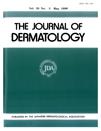An Assessment of the Role of Candida albicans Antigen in Atopic Dermatitis
Abstract
An immediate hypersensitivity reaction to Candida albicans (C. albicans) antigen has been observed in patients with atopic dermatitis. Recent data from a comparative study of the immune response to C. albicans antigen in patients with atopic dermatitis and non-atopics suggest a shift form type 1 helper T cells to type 2 helper T cells in the immune response to C. albicans antigen in atopic dermatitis. To delineate the role of C. albicans in the pathogenesis in atopic dermatitis, we evaluated skin reaction of C. albicans antigen, as well as the serum IgE antibody level against C. albicans in patients with atopic dermatitis, patients with nasal allergy, and non-atopics. In addition, the clinical effect of antifungal drugs was evaluated in the patients with atopic dermatitis. As a result, we found that immediate hypersensitivity to C. albicans antigen is strongly correlated with the patients with atopic dermatitis. On the other hand, the delayed-type hypersensitivity to this antigen, which is highly prevalent in atopics without dermatitis as well as non-atopics, was reduced in most of these patients. Antifungal drugs markedly improved the skin manifestations in patients with atopic dermatitis that have IgE antibodies against C. albicans, and the serum IgE levels also decreased. These results suggest that C. albicans antigen is a potent intrinsic factor in inducing skin lesions in atopic dermatitis because of IgE-mediated hypersensitivity of C. albicans antigen.




